First, nothing is "instantiated" in the .h file - that's just the public listing of what properties and methods are available to other classes. Think of the header file as a table of contents, but only for the things the class wants others to see.
Those properties don't exist in memory until the instance of the class itself is created, and then only if you set them to some initial value once they're needed.
How & where are you creating the 2nd view? Is it a storyboard segue or something? The 1st view doesn't seem to have any way of knowing the 2nd one exists, so it won't be able to see or access the label.
View1Class.m
#import View2Class.h
@implementation View1Class
- (IBAction)startPouring_ButtonClick:(id)sender {
//Instantiate the 2ndView when you need it.
// This gives View1 a reference to View2 and its public UILabel.
View2Class * my2ndView = [[View2Class alloc] init];
my2ndView.labelTimer.text = @"foo";
}
@end
As I said, it's still not clear how/where you're actually displaying the 2nd view though, so the snippet above is incomplete. You could use a modal w/a delegate, or this is where NSNotificationCenter is a helpful option - the 2nd view can sign up to get notifications & change accordingly. There are numerous tutorials about creating a 2nd/modal view and displaying it on a button click - you should probably look at those to clarify how the structure of such an app ought to work.
This answer should get you on the right track.
Other specific issues:
Why is the label nil? Because there isn't one...
In this IBAction, which seems to be in View 1:
- (IBAction)startPouring_ButtonClick:(id)sender
{
labelTimer.text = @"foo"; //this is looking for labelTimer in the clicked view.
}
... it is looking for its own labelTimer IBOutlet (in which case it should probably be self.labelTimer.text), and not that of the 2nd view. If the 1st view doesn't even have a UILabel IBOutlet, this is another problem.
If the views have different functions & different properties, they probably shouldn't be instances of the same custom class. If the 1st view doesn't have or need a UILabel, it shouldn't have one in its .h. If the 2nd view doesn't have or need a button it shouldn't have one in its .h. If the views serve different purposes, then make them different classes.
BTW,
Since you're using instance variables for your IBOutlets, you'd need to write your own getter & setter methods if you want to change their values. Did you? To make those values accessible to other classes, you'd need to make those methods public & put them in the .h. It's not good practice for an instance to set its instance variables directly w/o a getter/setter, and other objects definitely should not.
The preferred method is to use @properties for your IBOutlets instead of declaring them as instance variables. This will automatically create the getter & setter methods, backing store in memory, and as of XCode 4.4 it automatically adds @synthesize so you no longer need to do so. Declaring your IBOutlets as "weak" references prevents retain cycles & memory leak, where the view holds on to the outlets & the outlets hold on to the view & nothing ever goes away...
View1Class.h
@interface ViewController : UIViewController
@property (nonatomic, weak) IBOutlet UIButton *buttonSelectTimeInterval;
@end
View2Class.h
@interface ViewController : UIViewController
@property (nonatomic, weak) IBOutlet UILabel *labelTimer;
@end
